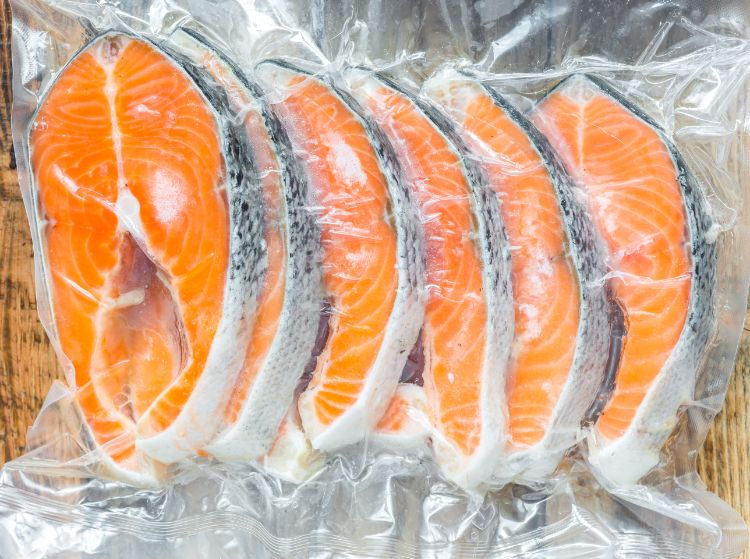When shopping for frozen fish, it’s easy to be drawn to the convenience of individually wrapped portions. Vacuum-sealed packaging, also known as Reduced Oxygen Packaging (ROP), offers a range of benefits—from extended shelf life to easy storage and preparation. However, there’s a hidden risk lurking behind this packaging that most people don’t consider. That risk is botulism—a rare but serious illness. Here’s why you should never thaw frozen fish in vacuum-sealed packaging and what you can do to avoid this health hazard.
What Is Botulism and Why Should You Be Concerned?

Botulism is a severe illness caused by a toxin that attacks the body’s nerves, resulting in muscle weakness, difficulty breathing, and in extreme cases, death. While botulism is most commonly associated with canned goods, it can also develop in vacuum-sealed packaging.
Clostridium botulinum, the bacteria responsible for botulism, thrives in low-oxygen environments, such as vacuum-sealed packaging. When frozen fish is removed from the freezer and begins to thaw at warmer temperatures, this environment creates ideal conditions for the spores of the bacteria to produce toxins. Understanding this risk is crucial for avoiding health problems when preparing vacuum-sealed fish at home.
Why Does This Happen with Vacuum-Sealed Packaging?
Clostridium botulinum is an anaerobic bacteria, meaning it can survive and grow in environments with little to no oxygen. Vacuum-sealed packaging, by design, eliminates oxygen to prevent spoilage and maintain freshness. While this works well for extending shelf life, it can become dangerous during the thawing process if not handled properly.
When fish in vacuum-sealed packaging is left out to thaw, the temperature rises above freezing, creating an ideal environment for these harmful bacteria to grow. Since the bacteria produce spores that release toxins, they can quickly multiply in the absence of oxygen, putting you at risk of botulism if the fish is not exposed to air.
How to Prevent Botulism When Thawing Frozen Fish
The good news is that preventing botulism from vacuum-sealed frozen fish is straightforward. By following a few essential safety tips, you can ensure that your frozen fish is safe to eat.
1. Store Frozen Fish Properly
To minimize the risk of botulism, it’s important to store vacuum-sealed fish at the right temperature—below 38°F (3.3°C). At temperatures above this threshold, the risk of bacterial growth increases significantly. Be mindful that many home refrigerators may not maintain temperatures below 38°F, so you should check your freezer’s temperature regularly with a thermometer to ensure it’s operating correctly.
2. Remove Fish from the Packaging Before Thawing

One of the most critical steps in preventing botulism is removing the fish from its vacuum-sealed packaging before thawing. By doing this, you allow oxygen to reach the surface of the fish, which prevents the growth of Clostridium botulinum. When thawing in an oxygenated environment, the risk of botulism-producing spores is reduced dramatically.
3. Follow Seller’s Thawing Guidelines
As with any frozen food product, it’s essential to follow the thawing instructions provided by the seller. These guidelines are designed to ensure the fish is thawed in a safe manner, minimizing the risk of bacterial contamination. Remember, vacuum-sealed fish is not shelf-stable and requires refrigeration even before thawing.
Best Practices for Buying, Storing, and Thawing Frozen Fish

Understanding how to safely handle vacuum-sealed frozen fish can protect you and your family from harmful bacteria. Here are some best practices to ensure your frozen fish remains safe for consumption:
1. Check Packaging Before Buying
Before purchasing frozen fish, inspect the packaging carefully. Avoid buying fish with torn or damaged packaging, as this could indicate improper storage or handling. Also, look for signs of frost or ice crystals, which could suggest that the fish has been thawed and refrozen, increasing the risk of spoilage. Ensure that the fish is rock hard when you buy it—this indicates that it has been properly frozen.
2. Store Fish at the Right Temperature
Proper storage is key to maintaining the quality and safety of your frozen fish. Keep the fish in your freezer at a temperature below 38°F. Invest in a reliable freezer thermometer to check regularly and ensure that the fish is kept at a safe temperature to prevent bacterial growth.
3. Thaw Gradually and Safely
When thawing fish, it’s best to plan ahead. Remove the fish from its vacuum-sealed packaging and thaw it in the refrigerator overnight. Thawing the fish gradually in the fridge ensures it stays at a safe temperature while also preventing the growth of harmful bacteria. Additionally, make sure the thawed fish is separated from other foods to avoid cross-contamination, especially with fresh produce.
Why Understanding the Risks Is Crucial

While vacuum-sealed packaging offers many benefits in terms of extending the shelf life of frozen fish, it’s important to be aware of the health risks involved if the product is not handled correctly. Botulism, though rare, is a serious illness, and understanding how to prevent its occurrence can save you from potential harm.
By taking simple precautions, such as removing the fish from vacuum-sealed packaging before thawing and storing it at the proper temperature, you can enjoy your frozen fish safely without worry. These small actions make a big difference in protecting you from the risks associated with Clostridium botulinum.
Conclusion: Safe Handling Is Key to Enjoying Frozen Fish
Frozen fish, especially those that come in convenient vacuum-sealed packaging, is a popular choice for many households. However, it’s important to understand the hidden risks and take the necessary precautions to prevent health issues like botulism. By storing the fish at the proper temperature, removing it from vacuum-sealed packaging before thawing, and following the seller’s guidelines, you can ensure your meals are both delicious and safe.
The next time you reach for that neatly packaged frozen fish, remember the importance of safe handling. With a few mindful steps, you can protect yourself and your family from potential dangers while enjoying the convenience and taste of fresh, high-quality seafood.


